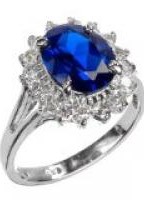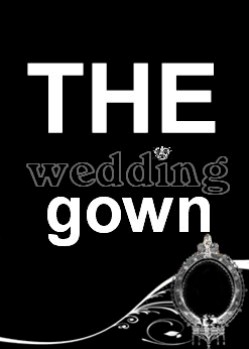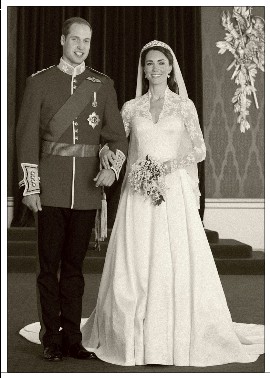| |||||
|
Royal Bride: Catherine Elizabeth Middleton |
|||||
|
Prince William married Kate Middleton … their wedding took place 0n 29 April 2011 at Westminster Abbey, London, England. HRH Catherine Middleton, the Duchess of Cambridge wore a classic elegant white full circle skirt gown with hand-cut English lace and french Chantilly lace used throughout the bodice and skirt and the underskirt trim - designed by Sarah Burton for Alexander McQueen. an exclusive
The Prince is second
line to the British throne after his father, Prince Charles.
The royal couple is now called "The Duke and Duchess of Cambridge".
These styles or titles are at the discretion of Queen
Elizabeth, who is William's grandmother. The Ring Description: Catherine Middleton (previously called Kate Middleton) received Lady Diana's engagement ring from Prince William Whales. It is an oval blue sapphire engagement ring that weighed in at an astounding 18 ct and was surrounded by 14 small diamonds in an elegant cluster setting.
|
_________
_________
|
||||
|
The wedding Dress Miss Catherine Middleton’s Wedding Dress has been designed by Sarah Burton at Alexander McQueen. Miss Middleton chose British brand Alexander McQueen for the beauty of its craftsmanship and its respect for traditional workmanship and the technical construction of clothing. Miss Middleton wished for her dress to combine tradition and modernity with the artistic vision that characterises Alexander McQueen’s work. Miss Middleton worked closely with Sarah Burton in formulating the design of her dress. The dress epitomises timeless British craftsmanship by drawing together talented and skilled workmanship from across the United Kingdom. The dress design pays tribute to the Arts and Crafts tradition, which advocated truth to materials and traditional craftsmanship using simple forms and often Romantic styles of decoration. Ms Burton’s design draws on this heritage, additionally giving the cut and the intricate embellishment a distinctive, contemporary and feminine character. The design The lace appliqué for the bodice and skirt was hand-made by the Royal School of Needlework, based at Hampton Court Palace. The lace design was hand-engineered (appliquéd) using the Carrickmacross lace-making technique, which originated in Ireland in the 1820s. Individual flowers have been hand-cut from lace and hand-engineered onto ivory silk tulle to create a unique and organic design, which incorporates the rose, thistle, daffodil and shamrock. Hand-cut English lace and French Chantilly lace has been used throughout the bodice and skirt, and has been used for the underskirt trim. With laces coming from different sources, much care was taken to ensure that each flower was the same colour. The whole process was overseen and put together by hand by Ms Burton and her team. The dress is made with ivory and white satin gazar. The skirt echoes an opening flower, with white satin gazar arches and pleats. The train measures two metres 70 centimetres. The ivory satin bodice, which is narrowed at the waist and padded at the hips, draws on the Victorian tradition of corsetry and is a hallmark of Alexander McQueen’s designs. The back is finished with 58 gazar and organza covered buttons fastened by Rouleau loops. The underskirt is made of silk tulle trimmed with Cluny lace. The Fabrics French Chantilly lace was combined with English Cluny lace to be hand-worked in the Irish Carrickmacross needlework tradition.All other fabrics used in the creation of the dress were sourced from and supplied by British companies. The choice of fabrics followed extensive research by Sarah Burton and her team. The Royal School of Needlework The Royal School of Needlework (RSN), based at Hampton Court Palace, assisted the Alexander McQueen team in accurately cutting out the delicate motifs from the lace fabrics and positioning the lace motifs with precision into the new design. The lace motifs were pinned, ‘framed up’ and applied with stab stitching every two to three millimetres around each lace motif. The workers washed their hands every thirty minutes to keep the lace and threads pristine, and the needles were renewed every three hours, to keep them sharp and clean. The RSN workers included existing staff, former staff, tutors, graduates and students, with the youngest aged 19. The RSN’s work was used primarily for the train and skirt of the Bride’s dress, the bodice and sleeves, the Bride’s shoes and the Bride’s veil. Veil and Jewellery The veil is made of layers of soft, ivory silk tulle with a trim of hand-embroidered flowers, which was embroidered by the Royal School of Needlework. The veil is held in place by a Cartier ‘halo’ tiara, lent to Miss Middleton by The Queen. The ‘halo’ tiara was made by Cartier in 1936 and was purchased by The Duke of York (later King George VI) for his Duchess (later Queen Elizabeth The Queen Mother) three weeks before he succeeded his brother as King. The tiara was presented to Princess Elizabeth (now The Queen) by her mother on the occasion of her 18th birthday. The Bride’s earrings, by Robinson Pelham, are diamond-set stylised oak leaves with a pear shaped diamond set drop and a pavé set diamond acorn suspended in the centre. Inspiration for the design comes from the Middleton family's new coat of arms, which includes acorns and oak leaves. The earrings were made to echo the tiara. The earrings were a personal gift to the Bride from her parents for her Wedding Day. Robinson Pelham have also designed and made a pair of diamond earrings for Miss Philippa Middleton. These earrings are more floral in nature to compliment the headpiece worn by Miss Philippa Middleton during the Service. A tourmaline and diamond pendant and matching earrings have been designed and made for Mrs. Carole Middleton. Two gold stick pins, one with a single gold acorn at the head and the other with an oak leaf, are also worn respectively by the Father of the Bride, Mr. Michael Middleton, and the Bride's brother, Mr. James Middleton. Wedding Shoes The wedding shoes have made hand-made by the team at Alexander McQueen and are made of ivory duchesse satin with lace hand-embroidered by the Royal School of Needlework. The Bride’s Bouquet The bouquet is a shield-shaped wired bouquet of myrtle, lily-of-the-valley, sweet William and hyacinth. The bouquet was designed by Shane Connolly and draws on the traditions of flowers of significance for the Royal Family, the Middleton family and on the Language of Flowers. The flowers’ meanings in the bouquet are: Lily-of-the-valley – Return of happiness Sweet William – Gallantry Hyacinth – Constancy of love Ivy: Fidelity; marriage; wedded love; friendship; affection (read more about meanings of flowers) Myrtle: the emblem of marriage; love. The bouquet contains stems from a myrtle planted at Osborne House, Isle of Wight, by Queen Victoria in 1845, and a sprig from a plant grown from the myrtle used in The Queen’s wedding bouquet of 1947. The tradition of carrying myrtle begun after Queen Victoria was given a nosegay containing myrtle by Prince Albert’s grandmother during a visit to Gotha in Germany. In the same year, Queen Victoria and Prince Albert bought Osborne House as a family retreat, and a sprig from the posy was planted against the terrace walls, where it continues to thrive today. The myrtle was first carried by Queen Victoria eldest daughter, Princess Victoria, when she married in 1858, and was used to signify the traditional innocence of a bride. from their official website |
|||||
|
>>>
|
|||||
|
Celebrity weddings (and wedding gowns) that have inspired! ...and continue to inspire... Be it expensive, OTT, long lasting, or cheap and quick... We have been entertained by celebrity weddings for as long as we can remember. They inspire us ...and sometimes disgust us, but boy, they sure can be original! It remains up to the individual to live their dream. | |||||
|
Bridal fashion has always been here. It is yours … IF you want it! | |||||
|
________________________________________________________________________________
Celebrity Bride main page / Enter this site / Bridal galleries / Read another article / Media request for an interview / Back to THIS month's free article / Back to homepage / Appointment procedures / Order information / Contact us / Enter Site / Consultations / Costs / Wedding gowns / Free articles / Celebrities / Background / Magazines / SA's best and worst / Save money / Matric farewell / Our official Fashion page / Play intro ________________________________________________________________________________ | |||||
| Disclaimer: As a fashion designer, I specialize in bridal and evening wear, I am an etiquette master and a style director. I do not proclaim to be an authority on any of the other subjects I write about. I merely share my experiences with those who wish to learn from it, or just read about it. Please contact us should you have additional information or information that proves otherwise. I am not the designer of any of the gowns that are published on this page, (unless so mentioned in the space allocated), nor have I made them, or photographed them, Photos were found googling, are widely available on the net, and where possible and available, the photographer will be credited. All images were translated to black and white and an antique filter was added to give an even playing ground to thowe who care about these articles | |||||
|
This month’s free article (archive) | |||||
Some live report back about what happened on the day... an exclusive
And then, on the balcony there was THE kiss! AND another one from a very shy Prince to his beautiful bride.... and the rest will soon be history.
The formal (official) photographs are being taken inside the palace.
Catherine was wearing a classic white Sarah Button from Alexander McQueen - with lace on top in a v-neckline. Hair in soft curls and very small tiara. View her gown view our suggestion
Catherine's Sister, Pippa has left for the Abby wearing something very simple in ivory, slight mermaid, boasting a cowl.
Two flowergirls are wearing white and floral crowns looking exactly like our suggestion! view our suggestion
Queen Elizabeth is wearing a sunny and bright yellow by Angela Kelly! If there ever was a very golden "pale" but very beautifull yellow, this is it! S ...and I reserve the right to comment later... an exclusive
Prince of Whales, Charles and Camilla, Duches of Cornwall, dressed in pale coulours too, ensemble by Anna Valentine, Phillip Tracy hat, shoes by Jimmy Choo. Cannot stop looking at the fascinating hats and fascinators.
Duchess of Kent wearing a beautiful chic pink gown with matching fascination.
Prince Andrew, and two daughters, Beatrice (5th in line to throne) and Eugenie (still a student) on their way. They do look very awkward and somewhat like lady gaga x 2 and I reserve the right to comment later...
Why does her dress look white?? ...and I so reserve the right to comment later... an exclusive
Mother in Law, Carol Middleton, (Catherine's mother) wearing pale blue hat by Jane Corbit and a matching suit. Her hair does not look formally done, and I reserve the right to comment later...
William (wearing red) stunning! and Harry (wearing black) have left for the Abby.
Dress widely expected to not be meringuely, and definate couture!
Sir Elton John and husband, David Furnish wearing elegant suits, and I reserve the right to comment later...
David Cameron's wife wearing the popular colour of the season to come: green!
SIX military bands along the route to the church...
I sooooooooo love the "pomp and circumstance"! Brittish ettiquette rocks.
The couple may receive additional titles.
David Beckham and Victoria: Victoria wearing one of her own designs? Mr Rademan will reserve comment on this till later...
No rain expected... The couple to take the horse carriage...
Truely a great day for royals... AND for commoners. More than 2 Billion people are watching ...
Prince William and commoner Catherine Middleton to be called "Duke and Duchess of Cambridge"...
![]()
![]()
![]()
![]()
![]()
![]()
![]()
![]()
![]()
![]()
![]()
![]()
![]()
![]()
![]()



